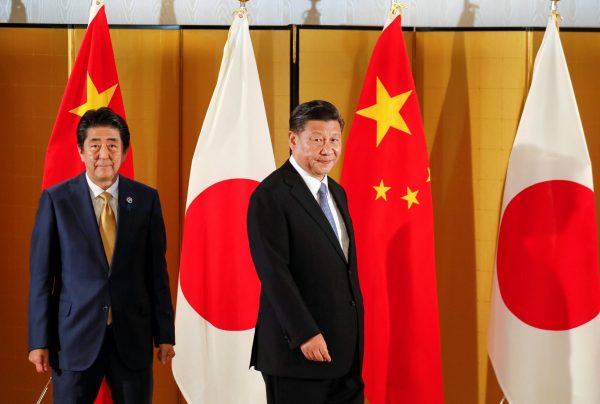The 11-member Comprehensive and Progressive Agreement for Trans-Pacific Partnership (CPTPP), covering 13 per cent of global GDP and 500 million people, came into force on 30 December 2018. One month later, the Economic Partnership Agreement (EPA) between Japan and the European Union took effect, heralding the largest open trade zone in the world — accounting for nearly one third of global GDP and 635 million people.
Fuelled by shared fears over the US–China trade war, China and Southeast Asian countries are now seeking to finalise the Regional Comprehensive Economic Partnership (RCEP) by the end of 2019. RCEP aims to cover areas such as trade in goods, trade in services, investment, rules of origin, intellectual property and electronic commerce. Japan has been pushing for high-standard rules during negotiations.
Japan’s leadership in global trade has had an unexpected impact on China’s FTA strategy, as well as its domestic economic and financial reforms. China is pushing for RCEP and initiating experimental measures in its domestic free trade zones with the aim of ‘wide ranging and high standard’ FTAs. The central government is considering adopting rules from the CPTPP and the Japan–EU EPA in areas such as negative lists, investor–state dispute settlements, intellectual property, environmental protection and worker protection.
RCEP, along with other FTAs, has always been a top priority in China’s foreign policy. At the 18th National Congress of the Chinese Communist Party (CCP) in 2012, the Chinese government set forth a policy of accelerating the establishment of FTAs. In 2015, the ambition ‘to establish a global FTA network’ along the Belt and Road region was written into the 13th Five-Year Plan.
Then US president Barack Obama declared that the United States would participate in the TPP, stating that ‘we can’t let countries like China write the rules of the global economy’. Leading scholars with close ties to top leaders in China asserted that RCEP without the United States could and would coexist with the TPP. RCEP and FTAs, in the eyes of China, were seen as the best platforms to blunt the TPP’s negative impact.
Despite US withdrawal from the TPP, the CPTPP and Japan–EU EPA are now in place. Given that the European Union is China’s largest trading partner while Japan ranks fourth, China is still making efforts to propel RCEP negotiations forward. To keep India in RCEP, China has promised that it will further liberalise its market in exchange for India’s acceptance of tariff-elimination under RCEP. China has also proposed an ‘ASEAN + 3 FTA’ as the first step towards RCEP.
The CPTPP and Japan–EU economic partnership arrangements have inspired China to further long-overdue economic and financial reforms. The Xi Jinping administration sees that the CPTPP and Japan–EU EPA demonstrate a vision for future global standards. These trade pacts entail rules and procedures of origin, reduce non-tariff measures and service trade barriers and aim to improve mutual market access for government procurement. Still, China has been reluctant to compromise in some areas such as environmental standards, data flows and intellectual property protection.
The creation of ‘comprehensive and high standard’ FTAs is one of China’s highest-priority policy goals. In the past 5 years, China has established 12 pilot domestic free trade zones and announced the establishment of six more partly in response to the conclusion of the CPTPP and Japan–EU EPA. The Shanghai Free Trade Zone, the first test area, was approved in July 2013 and started formal operations in September that year.
In this pilot free trade zone, most experimental policies are centred on finance and trade sectors, aimed at turning Shanghai into an international financial centre and free port. The government has gradually liberalised interest rates and capital accounts. It also founded the China (Shanghai) Pilot Free Trade Zone Court of Arbitration in 2013. If successful, the experimental policies adopted in the Shanghai Free Trade Zone are expected to be extended to other regions.
But economic liberalisation is not a foregone conclusion. The government’s newly released Report on the Development of China’s Free Trade Test Zone conceded that reforms in the financial sector have lagged behind those in the trade sector. Policies in the Shanghai Free Trade Zone which aim to hasten the process of internationalising the renminbi are inconsistent with existing policies outside the zone.
This makes policy implementation difficult. Financial liberalisation may also require political reforms aimed at ensuring an independent judiciary, building trust in the central bank and improving government accountability — all of which are impossible missions for a government that has explicitly dismissed notions of Western-style polity reform.
Prime Minister Shinzo Abe’s global trade leadership has brought out unexpected yet promising changes in China. The CPTPP and Japan–EU EPA may provoke market reform of the Chinese economy, since China is testing the water for further liberalisation in the pilot free trade zones. But despite Japan’s strong leadership, China has reached a tipping point where no further real economic liberalisation is possible without substantial political reform. Since President Xi is prioritising the elimination of all political risks that may jeopardise the survival of the CCP, real reforms are unlikely in the near future.
Rumi Aoyama is Professor at the Graduate School of Asia-Pacific Studies, Waseda University.
This article appears in the most recent edition of East Asia Forum Quarterly, ‘Japan’s leadership moment‘, Vol. 11 No. 3.

